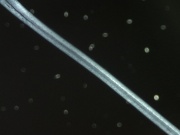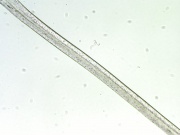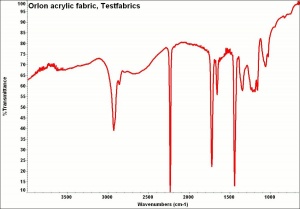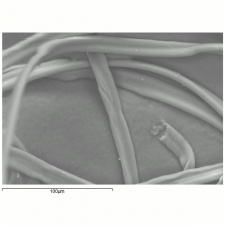Difference between revisions of "Orlon"
m (Text replace - "\[http:\/\/cameo\.mfa\.org\/materials\/fullrecord\.asp\?name=([^\s]+)\s(.*)\]" to "$2") |
|||
| (7 intermediate revisions by the same user not shown) | |||
| Line 1: | Line 1: | ||
| − | [[File:70 Orlon 200X pol.jpg|thumb|Orlon]] | + | [[File:70 Orlon 200X pol.jpg|thumb|Orlon at 200x polarized light]] |
| + | [[File:70 Orlon 200X.jpg|thumb|Orlon at 200x]] | ||
== Description == | == Description == | ||
| + | [[File:Image3_802551.jpg|thumb|Spun Orlon Type 75 Acrylic]] | ||
| + | [DuPont] A registered trademark for an [[acrylic_fiber|acrylic fiber]]. In 1950 Orlon® became the first commercially manufactured acrylic fiber. Orlon® is made from polymerized acrylonitrile. The acrylic resin is dissolved in a solvent, then extruded through spinnerets to produce long, continuous filaments. The smooth, thermoplastic fibers are resistant to wrinkles, chemicals, UV light, weathering, insects, mildew, and moisture. They produce fabrics that are lightweight, soft, durable and fast drying. They are, however, susceptible to heat and will melt or burn. Acrylic fibers are used for carpets, blankets, drapes, outdoor products and apparel such as sweaters, coats, linings, hosiery, dresses, and shirts. DuPont discontinued Orlon fibers in 1990. | ||
| − | + | For micrographs, please see http://cameo.mfa.org/wiki/Category:FRIL:_Acrylic | |
| − | |||
| − | |||
== Synonyms and Related Terms == | == Synonyms and Related Terms == | ||
acrylic fiber; DuPont Fiber A | acrylic fiber; DuPont Fiber A | ||
| − | + | [[[SliderGallery rightalign|OrlonTestfabrics.jpg~FTIR|orlon500am.jpg~SEM|orlon500bm.jpg~SEM]]] | |
| − | |||
| − | |||
| − | |||
| − | [[[SliderGallery rightalign|orlon500am.jpg~SEM|orlon500bm.jpg~SEM]]] | ||
== Comparisons == | == Comparisons == | ||
| Line 19: | Line 16: | ||
[[media:download_file_54.pdf|Properties of Synthetic Fibers]] | [[media:download_file_54.pdf|Properties of Synthetic Fibers]] | ||
| + | == Resources and Citations == | ||
| + | * Dupont: [http://www.heritage.dupont.com/touchpoints/tp_1941/depth.shtml History] | ||
| − | + | * G.S.Brady, ''Materials Handbook'', McGraw-Hill Book Co., New York, 1971 Comment: p. 12 | |
| − | |||
| − | |||
| − | |||
| − | |||
| − | |||
| − | |||
| − | |||
| − | |||
| − | |||
| − | * | ||
| − | * | + | * Richard S. Lewis, ''Hawley's Condensed Chemical Dictionary'', Van Nostrand Reinhold, New York, 10th ed., 1993 |
| − | * | + | * Random House, ''Webster's Encyclopedic Unabridged Dictionary of the English Language'', Grammercy Book, New York, 1997 |
* ''The American Heritage Dictionary'' or ''Encarta'', via Microsoft Bookshelf 98, Microsoft Corp., 1998 | * ''The American Heritage Dictionary'' or ''Encarta'', via Microsoft Bookshelf 98, Microsoft Corp., 1998 | ||
| − | * | + | * Rosalie Rosso King, ''Textile Identification, Conservation, and Preservation'', Noyes Publications, Park Ridge, NJ, 1985 |
| − | |||
| − | |||
| − | * | + | * Meredith Montague, contributed information, 1998 |
[[Category:Materials database]] | [[Category:Materials database]] | ||
Latest revision as of 15:28, 20 October 2022
Description
[DuPont] A registered trademark for an Acrylic fiber. In 1950 Orlon® became the first commercially manufactured acrylic fiber. Orlon® is made from polymerized acrylonitrile. The acrylic resin is dissolved in a solvent, then extruded through spinnerets to produce long, continuous filaments. The smooth, thermoplastic fibers are resistant to wrinkles, chemicals, UV light, weathering, insects, mildew, and moisture. They produce fabrics that are lightweight, soft, durable and fast drying. They are, however, susceptible to heat and will melt or burn. Acrylic fibers are used for carpets, blankets, drapes, outdoor products and apparel such as sweaters, coats, linings, hosiery, dresses, and shirts. DuPont discontinued Orlon fibers in 1990.
For micrographs, please see http://cameo.mfa.org/wiki/Category:FRIL:_Acrylic
Synonyms and Related Terms
acrylic fiber; DuPont Fiber A
Comparisons
Properties of Synthetic Fibers
Resources and Citations
- Dupont: History
- G.S.Brady, Materials Handbook, McGraw-Hill Book Co., New York, 1971 Comment: p. 12
- Richard S. Lewis, Hawley's Condensed Chemical Dictionary, Van Nostrand Reinhold, New York, 10th ed., 1993
- Random House, Webster's Encyclopedic Unabridged Dictionary of the English Language, Grammercy Book, New York, 1997
- The American Heritage Dictionary or Encarta, via Microsoft Bookshelf 98, Microsoft Corp., 1998
- Rosalie Rosso King, Textile Identification, Conservation, and Preservation, Noyes Publications, Park Ridge, NJ, 1985
- Meredith Montague, contributed information, 1998





